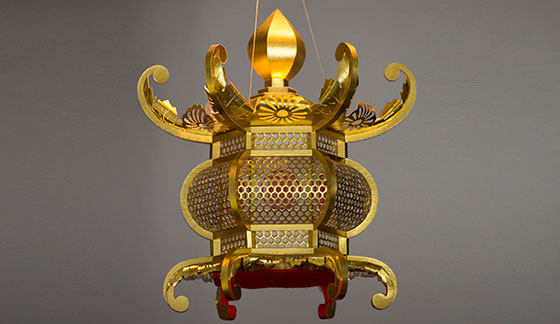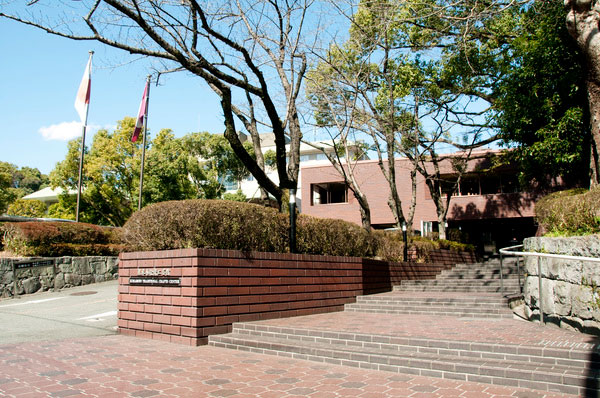
- Other crafts
- Kumamoto
Yamaga lanterns Yamaga toro
Traditional paper craft from the Muromachi period
A mirage of light and golden traditional paper
Description
What is Yamaga lanterns ?
Yamaga toro are lanterns made of washi (traditional Japanese paper) produced in the area surrounding the city of Yamaga, Kumamoto prefecture. For the Yamaga Lantern Festival, an annual summer event, this craft is worn by one thousand dancing women wearing yukata (summer cotton kimono). Also, offerings of detailed shrine or castle replicas made to scale at around 1/20 to 1/30 reduction are given to the local Omiya Shrine during this festival.
This craft is unique for being made entirely of washi, glue, and with tools like a ruler, small knife, scissors, and flat iron but not clasps or fittings. While tools are used to make the architectural curves of the lantern, there is no space left for gluing and paper thickness is used to make the seams. These lanterns are made to scale, but the artisans add unique tricks of perspective and visual illusion to make any observer feel as though they are looking at the front of a real miniature building. Because the lanterns look so substantial and solid, it is hard to believe they are only made of paper. In 2013, Yamaga toro was designated as a Japanese traditional craft.
History
There are a number of legends concerning the history of Yamaga toro. One of the most told stories dates back to Emperor Keiko, the 12th emperor of Japan who reigned from 71 to 130 A.D. He was doing an imperial tour of the Kyushu region and got caught with his entourage in a very thick fog around the Kikuchi River flowing through the Yamaga area. Villagers lit torches to guide and welcome the party to the Omiya Shrine, which still exists today.
Since then, torches had been offered to the Omiya Shrine every year until in the Muromachi period (1336-1573), when they were replaced with paper gold lanterns. Historical records state that in the Edo period (1603-1868), wealthy merchants commissioned lantern artisans to make a particularly beautiful style of lantern, which they did in the style of a Japanese tatami room or five-storied pagoda still seen today.
Another reason for the development of Yamaga toro is the start of papermaking in the Yamaga area, which was a result of the battles of Bunroku and Keicho fought in Korea starting in 1592. Around this time, Kato KIYOMASA, a lord, returned with his army to Japan, and brought two papermakers, Kyoshun and Dokyo. The two artisans were officially commissioned to spread Japanese paper production, and later, Kyoshun moved to present day Yamaga, and introduced papermaking skills throughout the area. The industry thrived and led to the area around Yamaga becoming an important paper producing center which also helped promote Yamaga toro.
Production Process
- 1. Backing
Yamaga toro must be made from handmade washi (Japanese traditional paper). Even gold and silver paper are lined with washi.
- 2. Pricking
Using a bugami (paper pattern) with holes marking out the dimensions of each part, indicator points are pricked with a needle on the lantern paper, clearly marking lines for folding or cutting. Even though each lantern is small, they can contain as many as two hundred parts.
- 3. Line marking
A hotarugai or metal spatula is used to mark lines on the lantern paper to indicate links between the prickpoints.
- 4. Cutting the roof, compound pier, and hexagon
The parts for the roof, compound pier, and hexagon of the lantern are cut out with a small knife.
- 5. Paper pattern and pencil drawing
Curves are marked using a pencil and paper pattern.
- 6. Cutting other parts
Any remaining parts are now cut out with a small knife. For the ornamental rooftop section, since there is no space for gluing, the edges are chamfered or cut at a 45 degree angle.
- 7. Gluing
All individual sections are glued in preparation for the full assembly.
- 8. Assembly of the ornamental rooftop
The ornamental rooftop is made of six sections and the chamfered edges are carefully assembled.
- 9. Assembly of the entirety
Finally each assembled section is joined together to complete a magnificent golden Yamaga toro.
Facility Information
Kumamoto Perfectural Traditional Craft Center
 Photo:Kumamoto Prefecture
Photo:Kumamoto Prefecture
-
Address
-
Tel.+81-96-324-4930
-
ClosedMondays (open if Monday is holiday and closed the next day), December 28 to January 4
-
Business Hours9:30am to 5:30pm
-
Website
Other Other crafts
- Edo kiriko cut glass
- Koshu lacquered deer leather
- Kyo folding fans
- Marugame uchiwa fans
- Boshu uchiwa fans
- Gifu lanterns
- Yamaga lanterns
- Kyo uchiwa fans
- Tendo Japanese chess pieces
- Edo glass
- Edo patterned paper
- Yame lanterns
- Owari Cloisonné
- Fukuyama Koto (Japanese Harp)
- Kyo art preservation
- Banshu fly-fishing flies
- Woodblock prints
- Koshu hand-carved seals
- Edo Hyogu (Art Mountings)
- Edo tortoise shell crafts
- Etchu Fukuoka Sedge Hats
- Gifu Japanese Umbrellas
- Nagasaki tortoise shell crafts
- Nagoya Sekku Kazari
- Sanshin
- Tokyo Koto (Japanese Harp)
- Tokyo Shamisen































































































































































































































































































